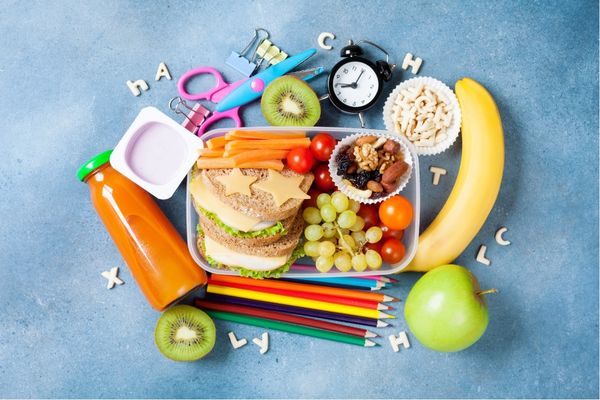USDA Issues Proposed Updates to Nutrition Standards
February 09, 2023
On February 3, USDA issued a new proposal to update the nutrition standards to align with the 2020 Dietary Guidelines. Comment period ends on April 10. Here's what you need to know:
Added Sugars
For the first time, USDA is creating limits on added sugar in products served. The rule proposes a phased in approach:
- First, beginning in fall of 2025, the rule proses a limit on added sugars in certain products, targeting the most common sources of added sugars in school meals: breakfast cereals, flavored milks, grain-based desserts, and yogurt.
- Grain-based desserts (cereal bars, doughnuts, sweet rolls, toaster pastries, coffee cakes, and fruit turnovers): no more than 2 ounce equivalents per week in school breakfast, consistent with the current limit for school lunch.
- Breakfast cereals: no more than 6 grams of added sugars per dry ounce. This would apply to CACFP as well, replacing the current total sugars limit.
- Yogurts: no more than 12 grams of added sugars per 6 ounces.
- Flavored milks: no more than 10 grams of added sugars per 8 fluid ounces for milk served with school lunch or breakfast. For flavored milk sold outside of the meal (as a competitive beverage for middle and high school students), the limit
would be 15 grams of added sugars per 12 fluid ounces.
- Second, in fall 2027, the rule proposes limiting overall added sugars across the weekly menu to less than 10% of calories per meal, on average, to better align meals with the dietary guidelines.
Sodium:
The proposed rule includes different reductions and target levels for breakfast and lunch. For lunch, the rule includes three reductions that are phased in every 2 school years: 2025, 2027 and 2029. Breakfast will only have two reductions in 2025 and 2027. Each reduction will decrease sodium by 10%. The sodium targets are aligned with the FDA actions on reducing sodium in overall food products.
For milk and whole grains, USDA has provided two options and have asked for public feedback for which one will work better for students, schools and partners.
Milk:
- Option 1: Limit milk choices in K-8 to a variety of unflavored milks only and allow flavored milk for grades 9-12.
- Option 2: Keep current proposal allowing to offer fat-free and low-fat milk, flavored and unflavored (but subject to sugar constraints).
Whole grains:
- Option 1: Maintain the current requirement that at least 80% of the weekly grains offered are whole grain-rich, based on ounce equivalents of grains offered.
- Option 2: Allow schools to serve non-whole, enriched grain foods – like refined, enriched pasta or flour tortillas – one day per school week.
Definition of “whole-grain rich”: Indicates that the grain content of a product is between 50% and 100% whole grain with any remaining grains being enriched.
Additional changes to note include:
Traditional Foods: Allows tribally operated schools, BIEs, or schools who serve primarily American Indian or Alaska Natives to serve vegetables to meet grain requirement. Explicitly states that traditional foods may be served in reimbursable school meals. “Traditional food” refers to food that has traditionally been prepared and consumed by an American Indian tribe, including wild game meat; fish; seafood; marine mammals; plants; and berries.
Flexibilities for menu planning:
- Aligns NSLP afterschool snack standards with CACFP snack standards for school-aged children. Snacks would include two of these five components: milk, vegetables, fruits, grains, meat/alternates.
- Continues to allow schools to substituting vegetables for fruits at breakfast but those who do so more than once a week must offer at least two vegetable subgroups. Schools are not required to offer vegetables at breakfast, and may choose to offer only fruits at breakfast to meet this component requirement.
- Allows nuts and seeds to credit for full meal/meal alternate component.
- Adds hummus to the list of foods exempt from the total fat standard in the Smart Snack regulations.
Administrative/Operational Flexibility:
Hiring Standards: Allow state agency discretion to approve the hiring of program directors in medium (2,500 to 9,999 students) and large (10,000 or more students) districts with 10 or more school nutrition experience but who do not hold a bachelor’s or associate’s degree. Flexibility to the hiring standards is already provided for small districts.
Buy American: Provides clarity on exceptions of the Buy American requirement 1) The product is not produced or manufactured in the U.S. in sufficient and reasonably available quantities of a satisfactory quality; or 2) Competitive bids reveal the costs of a U.S. product are significantly higher than the non-domestic product.
Also sets a 5% ceiling on the non-domestic commercial foods a school food authority may purchase per school per year.
Geographic Preference: Expand geographic preference options by allowing locally grown, raised, or caught as procurement specifications (a written description of the product or service that the vendor must meet to be considered responsive and responsible) for unprocessed or minimally processed food items in the child nutrition programs, in order to increase the procurement of local foods and ease procurement challenges for operators interested in sourcing food from local producers.
Additional support from USDA:
As part of the announcement regarding the regulations, USDA shared additional plans for how they intend to support school districts for implementation:
- Healthy Meal Incentive Grants for Small and Rural Districts: $30 million in grants to small and rural districts to improve the nutrition of their school meals. Implemented in partnership with Action for Healthy Kids.
- School Food System Transformation Challenge Sub-Grants: Through partnerships between various entities, FNS will support the development of innovative solutions to transform K-12 food service. As part of these grants, grantees will work with industry partners (agricultural producers, growers, processors, etc.) to develop creative solutions to provide nutritious foods for school meals.
Author


